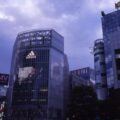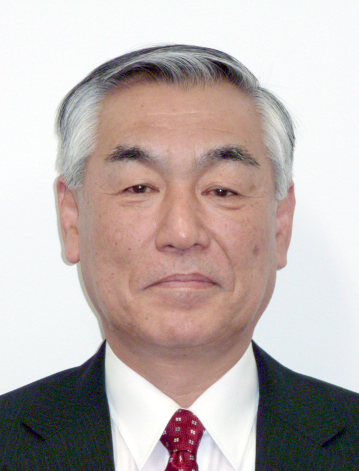DESIGN BEYOND FORM: THE ART OF YOSHIOKA TOKUJIN
KŌNO MICHIKAZU I understand this office is a converted rice warehouse that you had moved here from Shimane Prefecture back when you first opened your own design studio in 2000, and furthermore that you were personally responsible for everything from the architectural and interior design to the hiring and supervising of contractors.
YOSHIOKA TOKUJIN I wanted to do something completely new but within my resources, which were limited. Since many of my clients are from overseas, I wanted to build a studio that would appeal to them and to present something uniquely Japanese to the world. My idea was to incorporate both Japanese tradition and futuristic elements. So I decided to create contemporary architecture out of a 150-year-old structure.
Traditional Japanese houses typically use local materials, like timber and clay. I wanted to use the local materials of contemporary Tokyo, and I decided that the closest counterparts were industrial materials. More than anything, l wanted to achieve a futuristic effect through the contrast of traditional natural and contemporary industrial materials.
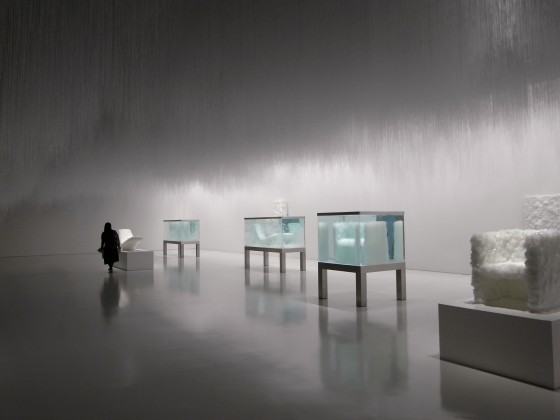
“Second Nature” show directed by Tokujin Yoshioka, held at 21_21 DESIGN SIGHT (http://www.2121designsight.jp), Tokyo. ©Masaya Yoshimura
KŌNO Like the contrast between the thick wooden beams and the stainless steel partitions. You’ve achieved a delicate balance between the mellow, subdued quality of the old materials and the edginess appropriate to an idea factory. I would imagine that this building has a very special place in your oeuvre, being your base of creative activity as well as one of your representative works.
YOSHIOKA Yes, although I do think about work at home, this is where I do practically all my experimenting and actual creating.
Unseen Form, Formless Design
KŌNO I enjoyed your book Mienai katachi [Invisible Forms]. I’d like to ask you some questions based on some of the key concepts and expressions that appear in your writing, beginning with the title–unseen or invisible form. You’ve said, “I don’t design objects, I design feelings.” What does it mean to “design feelings”?
YOSHIOKA I think this is very difficult period of time for a designer. People are not buying things as much as they used to, and they are surrounded by many more products than they need. I have given a lot of thought to what it means to create things or be a designer in this sort of world. And for me the key is to create for people. Whether it is art or design, the creation has to be oriented to people.
I have also thought about what our society will look like in the future. Until recently, the design of a sound recorder was predicated on the need to insert cassette tapes. But now that cassette recorders have given way to IC recorders, there is hardly any need for a particular form. As digital technology develops, material form is fading away. So what is a designer supposed to design? It seems to me that we are entering a transition to an era of feeling, when people are going to find more value in experience and sensation than in material objects, and that is where the business opportunities will be. In the past, most people were reluctant to pay for anything they could not see, but more and more they are going to be willing to pay for things that have a big impact on the emotions even though they have no visible form–things like relaxation, for example.
KŌNO In other words, sensations like touch and smell that elicit emotion? Are you saying you’re interested in a kind of design that manipulates unseen elements like that to strike an emotional chord in people?
YOSHIOKA The truth is that we have not really figured out the mechanisms that cause people to respond to things emotionally, to fall in love, to change from one mood to another, and so forth. But we do know that for some reason there are quite a few stimuli to which all human beings innately respond in the same way, regardless of personal or cultural differences. I want to use those stimuli as one key to design.
KŌNO In that case, where would the initial image for a design come from? Taking the example of a chair, if you envisioned a chair from the standpoint of feeling instead of form, how would it take shape?
YOSHIOKA The first thing to consider is what I am trying to accomplish with any given design–the purpose of the project. What is the background? Is a change of design needed? Do I want to develop a totally new design, or retain elements of the current design? There are all kinds of situations. I begin by thinking about what it is the client wants to accomplish. Next, I think beyond the client, the customers. Then, even if I come up with a different idea from what my client originally had in mind, they will often come around and say, “Come to think of it, that could work.”
What people really want from a designer is atmosphere. You could go about that in an additive fashion; in interior design, for example, you could do it by changing the walls, then the floor, then adding furniture, and so forth. But that leads to a superficial design lacking much freshness or excitement. To me it is important to approach design by changing things at a very basic level.
Take window installations. To my mind, the essential impact of a window installation comes from amorphous elements like movement and light. I designed my Hermès scarf window installation around the idea of wind. The whole thing is almost devoid of material objects. I began by thinking about what it is that makes the Hermès scarf beautiful and how best to highlight that. The Hermès scarf is such a high-quality object in itself, any extra ornament or noise could only distract from that. I came up with the image of a scarf around a woman’s neck, blowing in the breeze, and I decided to make a design using the wind. I ended up with the image of a woman blowing air from her lips and the scarf swaying softly in the air in response to the woman’s breath. We had to experiment a lot to get it right, since the wind has to come out of a tiny 1-millimeter hole. I composed every element of the image, including the model’s makeup. That’s the only way you can create beauty, through meticulous attention to the smallest detail.
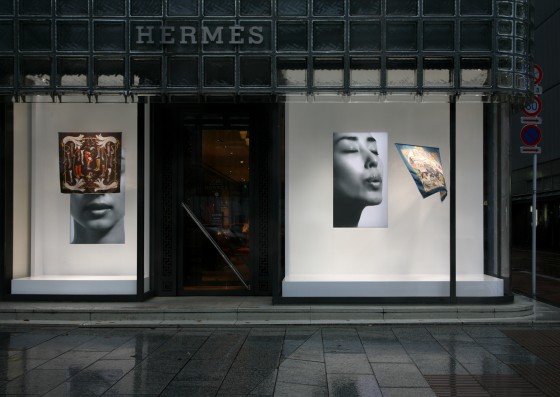
Yoshikoka’s Maison Hermès Window Display was on show from 19 November, 2009 to 19 January, 2010. Courtesy of Hermès Japon.
I love that sort of indescribable feeling of excitement and the feeling of air. Sound and smell are mysterious things. It is interesting to me that a particular sound can evoke very much the same feeling in everyone who hears it. The more I think about it, the stranger it seems. And I often get the feeling that certain human responses or impulses that one imagines have been lost in our modern society, with all its conveniences, are still lurking inside us. Feelings that one may not have consciously experienced for a long time, and that seem to have vanished, are actually just dormant. I think that from now on one of the key functions of design is going to be awakening all these feelings sleeping inside us.
Nature and the Japanese Aesthetic
KŌNO At one point you write, “The clouds I saw from the airplane were so beautiful that I wanted to take them home with me,” and you have a passage about the “special silence of a snowy morning.” I’m especially interested in the passage where you write, “To one degree or another everyone has memories of nature’s astonishing beauty, which may float to the surface unexpectedly. In my case, such memories are apt to thrust themselves into my consciousness when I am in the process of creation.” It seems to me that what you’re describing is very similar to Rachel Carson’s “sense of wonder.” Did your upbringing in Saga Prefecture give you opportunities to relate to nature from an early age?
YOSHIOKA It was not the big city, but it is not as though I grew up in the midst of nature either. As children we would play along the banks of the river, but I do not think I was particularly aware of nature’s wonders.
Still, one day the editor of a Dutch magazine remarked to me that the reason people rarely react negatively to my work is that my designs create the same feeling one has when looking at nature, and no one reacts negatively to natural beauty. He said that in that sense my design was almost like a universal language that can communicate to people of all cultures. I was very intrigued by that. But I was not conscious of nature as an inspiration when I started out. I began to notice that the laws of nature and the essence of the sensations we take from nature inhabit my design after it was pointed out to me that my work had that quality to it.
KŌNO Your early works tend to be more conceptual and minimalist, I think. You didn’t have the same feelings toward nature at that time, then?
YOSHIOKA I never really thought about it. I had just come to Tokyo from the provinces, and I was still dazzled by the big city. I first began to think about nature when I presented my work abroad in 2006.[1. Yoshioka presented an installation for Lexus in 2006, “Evolving Fiber Technology,” in Milan.–Ed.] When I take part in an exhibition overseas, I get all kinds of questions and comments from people I do not even know. I got a lot of feedback from people telling me that certain aspects of my work that I had never really thought about were very Japanese. That made me more aware of some of the distinguishing features of my design, and made me decide to develop these aspects of my work.
The Creative Process
KŌNO I’d like to talk a little bit about the design process. How do you get from your initial image to the final design? Is it basically trial and error?
YOSHIOKA At first, the image is quite vague. I keep developing and refining that initial image, gradually bringing it into focus. I experiment over and over, and in the process the image is transformed. Perhaps a design I have originally envisioned as red will incorporate a blue element, and then I think, “That’s really beautiful. I think I’ll make the whole thing blue.” And then again, sometimes I go back to the original image. The more you experiment, the more accidents are going to occur, and the beauty of the unexpected coincidences is something you can never duplicate through intellectual calculations or sketches. These kinds of beauty can only be created through actual practice. I keep adding those things, and sharpening the focus, and in the process the design gradually takes shape.
KŌNO So, you basically try this and that until you finally you come up with something that makes you say, “This is it”?
YOSHIOKA That is right. Along the way I never discuss my ideas with anyone. Development takes time, but while I am working on it, it is all strictly confidential among those directly involved. When the design is complete, I unveil it all at once.
KŌNO About how long does a project take?
YOSHIOKA That all depends on the project. I am pretty quick with the concept. You cannot make ideas come by spending a lot of time on them, after all.
KŌNO Do you find the process of bringing your ideas to fruition is fun or arduous?
YOSHIOKA It is hard work but fun. Or perhaps I should put it other way around: Fun hard work. Creating what has never existed before takes time. Making the impossible possible requires lots of testing and verification. You have to conduct experiments to test for durability. In some cases we are the first to come up with the basic data pertinent to a certain project.
KŌNO Do you ever get discouraged, or are you generally confident that you’re moving toward the goal line?
YOSHIOKA Things get difficult when I am not excited about something. As long as I am excited, and I can clear the feasibility hurdles, then I feel confident it is going to work, and I forge right ahead. But the first condition is the excitement. As long as I feel that way about it, I know I can see it through to completion.
KŌNO Do you get outside experts to assist you with things like new materials and technologies, or do you learn what you need to know yourself?
YOSHIOKA If it happens to be a material I am interested in and have a general idea about, we usually do the research ourselves. But I do not necessarily make a point of being on the cutting edge. In some cases the design is more likely to stay fresh with older materials and technologies. The newest things can seem dated after a year or so. I am more interested in using common, ordinary materials and technologies in a creative way to produce something that looks fresh and new. In the case of the crystal chairs, I began with the idea that I wanted to make a chair that looked like that. Then we did all kinds of research in order to realize the idea. We may be amateurs when we begin, but we tackle a problem with the aim of being professionals by the time we finish. The study of materials is not something that ends with a particular design project. Everything ties in with the next. The key challenge is always finding the practical means of creating something of high quality, while keeping costs in mind.
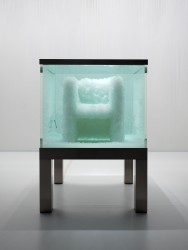
The “Venus–Natural Crystal
Chair” design was part of the
“Second Nature” show directed by
Tokujin Yoshioka, held at 21_21
DESIGN SIGHT
(www.2121designsight.jp), Tokyo.
©Masaya Yoshimura
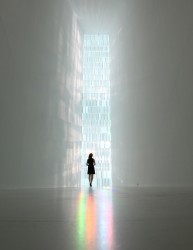
The “Rainbow Church” installation
held in Seoul in 2010 featured
nearly nine meters of “stained
glass” made from 500 crystal prisms.
KŌNO How does it feel when it’s all over and you’re standing before your completed work?
YOSHIOKA Standing before the completed work, it is sometimes hard to believe that this object is something I have designed. I sometimes feel, “How did I do that?” I think that relates to accidental elements beyond my own imagination.
KŌNO Are those the works that give you the greatest feeling of achievement–the ones that don’t strike you as something you created yourself?
YOSHIOKA I feel the greatest sense of achievement with projects that excited me from the outset. A project that seemed impossible at first would bring me this excitement.
KŌNO How does it feel to hear other people’s opinion of your work?
YOSHIOKA After a work has been unveiled, I become like a part of the audience. I forget all the hurdles and the obstacles along the way and just look at the final product objectively. I take in the opinions of a lot of people, and that feedback helps motivate the next project. Sometimes I tap that feedback for new ideas.
KŌNO In terms of the element of the accidental, are there sometimes benefits to doing several projects at one time?
YOSHIOKA Yes, when you do more than one project at a time, the projects are bound to influence each other in some way, even if they are outwardly very different. Sometimes I hit on a solution to a design when I am thinking about a different project. Concentrating on just one at a time can get you in a rut and be surprisingly unproductive. The way I work is like a rhythmic piece of music made up of many different layers of sound.
Working with the Client
KŌNO You’ve suggested that the new frontier in design is tapping into all kinds of human feelings. Is there anything you do consciously, for example to hone your sensitivity or open yourself up to new ideas in this area?
YOSHIOKA Nothing special, but I am always asking myself “why.” For example, smells can elicit certain memories in people, which in turn elicit images. The same thing is true with sound. Happy music makes you feel happy, sad music makes you feel sad. I am fascinated by how that works. Why does music move people’s emotions in this way? Music is not something that acts only on the ear; it involves all five senses. By the same token, as I see it the building blocks of design are not just visible objects but the whole range of human sensations and feelings. The formless design I envision is a bit like music or perfume in this sense.
KŌNO At times I imagine it can be difficult getting a client to understand the idea of formless design.
YOSHIOKA When I present my idea to the client, I only submit one idea. Then I see if that idea is in the right direction. But the idea I submit is the result of deep thinking about the purpose and essence of the project.
Take the Cartier exhibition.[1. Yoshioka curated the “Story of . . . –Memories of Cartier Creations” exhibition held at the Tokyo National Museum in 2009.–Ed.] With a jewelry exhibition, people are apt to zero in on things like how big and sparkly the diamonds are. But it seemed to me that the concept of such an exhibition should be the stories behind the jewelry–the lives of the people who wore it, the history of the company that created, and so forth. I incorporated that idea into my proposal, and they liked it.
When I did the Lexus installation in Milan, they told me they wanted the car to be front and center. I would probably feel that way too if I were the client. But I suggested that it would be difficult to get the company’s philosophy across just by displaying the car. First express the ideas, indicate what you want to convey–not by providing explanatory text but by getting people to feel it themselves. Then, when you show the car, it will look different. I decided to begin with a presentation that embodied the Lexus design philosophy of “L-finesse,” which ties in with Japanese concepts of hospitality and beauty. I designed the whole installation around this focal point, L-finesse. My idea was to get people interested in the concepts underlying the installation and get them thinking about the meaning of creation.
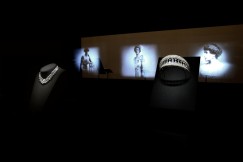
“Story of . . . –Memories of Cartier
Creations”(www.storyof.jp) directed by
Tokujin Yoshioka
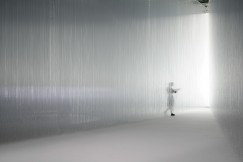
A scene from the Tokujin Yoshioka x Lexus
L-finesse Evolving Fiber Technology
installation for Lexus in Milan. © Nacása &
Partners, Inc.
KŌNO Are you always conscious of yourself as a Japanese designer, a representative of Japanese culture?
YOSHIOKA In the past I never considered it. In the final analysis, I think it is more important for me to be true to myself than to be Japanese. I think that is the most significant thing that one has to offer the world. Today every part of the world is connected by the Internet, and the dominant trend seems to be toward globalization and a flat world. Yet at the same time, it seems to me that people are more than ever drawn to things that are regionally distinctive, things that can only be found in a certain country, modes of expression that can only come from people raised in a particular culture.
KŌNO You’ve written that you want to make things that will live on after you’re gone, and that you want to design the “classics of the future.” More specifically, do you have any ultimate goals that you’re striving toward in your work?
YOSHIOKA I love creating, so all I want to do is to keep on creating and to move people with my creations.
Translated from an original interview in Japanese. [March 2011]

